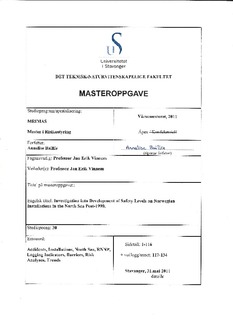| dc.description.abstract | There have been no major fatal accidents in the Norwegian sector after 1985, and those which occurred before that are not considered very relevant to the current investigation, because circumstances and policies differed considerably from current practice. However, there have been numerous minor accidents, including occupational accidents, near-misses and dangerous occurrences, known as lagging indicators. Can we deduce that installations built in the last decade are significantly safer than those constructed prior to year 2000? In this report, our working hypothesis will be to attempt to prove that installations built in and after 2000 have significantly less dangerous occurrences (known as lagging indicators) and greater inherent barriers (known as leading indicators) against major accidents than those following earlier regulations.
The RNNP database contains relatively systematic information on minor accidents and near-misses, from and including 1996, so it will be used as source for our investigation. There is no similar overview for events prior to 1996, as the data either does not exist, or only for a few incidents. For barrier data, systematic information is available from and including 2002. Statistics will be presented and discussed both chronologically, and by type of accident, for the lagging indicators; and by type only for the leading indicators, to determine actual trends in safety levels. The lagging indicator data has been normalised by number of installation years and by number of million man-hours.
For the report, both risk analyses and experience data from the offshore business will be drawn upon to be able to compare the detailed plans prepared before start of production with the actual events and reality on the installations. The investigation will be carried out at sector level, not on the basis of each individual installation. However, I will be connecting the RNNP data with risk analyses for some selected installations.
Helicopter accidents are excluded from the investigation, as it is a very different topic, and would constitute a thesis in itself.
The data show inconclusive results. There are no significant differences between number of leaks of installations built before and after 2000, the most important lagging indicator, when the results are normalised. However, for leading indicators gas detection and ESDV riser, the differences are statistically significant once outliers are removed. Installations built in or after 2000 have fewer well-kicks, minor fires, field vessel collisions and structural damage, but the differences are not statistically significant. | en_US |
